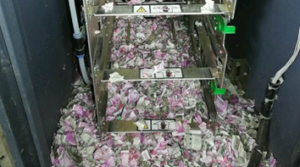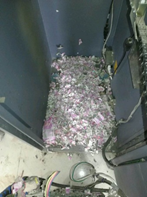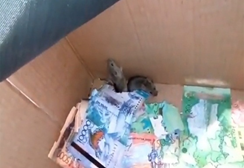 How could a creature stay underground for years and appear on the over the ground all of a sudden!
How could a creature stay underground for years and appear on the over the ground all of a sudden!
Cicadas do this!
Cicadas are oval-shaped, winged insects that provide a buzzing and clicking song heard in nature. Most cicadas appear every year in late June through August, while others emerge only every few years.
There are around 3,000 cicada species, so they vary in size from 0.75 to 2.25 in long. Cicadas can be black, brown or green and can have red, white or blue eyes.
Their wings are transparent and can seem rainbow-hued when held up to a light source. The veins on the tips of the wings of some cicadas make the shape of a W. They live a relatively long time — 4 to 17 years, depending on whether they are annual or periodical cicadas. The periodical cicadas live the longest. The 13 or 17-year life cycle of a periodical cicada begins when an adult female cicada lays her eggs in slits she cuts in the twigs and branches of trees. When the eggs hatch, they nymphs or juveniles drop to the ground and burrow into the soil. The growing cicada then spends the next 13 to 17 years underground as a nymph.
 A group of these insects is called a cloud or plague. Cicadas are herbivores. This means they eat vegetation. Young cicadas eat liquid from plant roots while molting cicadas eat twigs.
A group of these insects is called a cloud or plague. Cicadas are herbivores. This means they eat vegetation. Young cicadas eat liquid from plant roots while molting cicadas eat twigs.
Cicadas are among the loudest insects known to man, and a swarm of them can produce sounds up to 120 decibels. That’s louder than a rock concert (about 115 decibels), and comparable to the noise from a chainsaw.
Cicadas loudest in four years as Sydney experiences a bumper season
Sarah Falson – DECEMBER 20 2017 – 11:00 AM – Hawkesbury Gazette.
YOU’D be right if you thought the cicadas were a little louder this year. Sydney is experiencing a bumper season – the largest since 2013 – and leafy areas of the Hawkesbury are teeming with the vociferous invertebrates.
Their chorus is so loud in some suburbs (including Bowen Mountain where this journalist lives) that simply being outside amongst the trees, once peaceful, has become a little stressful.
Then, once the sun goes down and the cacophonous chorus calms, the boisterous bugs find other ways to make nuisances of themselves – like flying into the nearest person’s head en route to gather around the glow of the garden light.
Billions of Cicadas Set To Invade the Northeast in May
By James Crugnale – The Weather Channel
April 15, 2016
The red-eyed, loud, humming insects are expected to emerge in parts of Ohio, Pennsylvania, Maryland, Virginia and West Virginia. The critters, which are part of the “Brood V,” will then spend the next four to six weeks mating and laying eggs.
Gene Kritsky, a cicada expert at Mount St. Joseph University told weather.com in a phone interview that when the ground reaches the magic temperature of 64 degrees Fahrenheit, the insects will burst out, though unseasonable continental warming could affect their surge
Kritsky assured that the insects were not dangerous to humans.
“They’re sucking insects,” he said. “These guys will puncture the bark of trees but won’t cause any harm (to people). They’re actually quite beneficial for ecology — (their emergence) helps rain get to roots faster.”
C Tech Corporation can offer an eco-friendly solution to problems with cicadas. Our product Combirepel™ is a low-toxic, non-hazardous and insect aversive. Our products work on the mechanism of repellence and they do not harm or kill the target species but generate fear or trigger temporary discomfort within the pests that keep the pests away from the application.
Our product works on the mechanism of repellency. It temporarily inhibits the mating cycle of the insects. The product impairs the ability of the insects to reproduce, that is the insects will not lay eggs or the laid eggs will be infertile. The product causes feeding disruption in an insect by triggering an unpleasant reaction within the insect which might try to feed on the application. The product temporarily blocks the reproduction system of the insects by hindering the release of the vital hormones for growth.
Our product is compliant with RoHS, RoHS2, ISO, APVMA, NEA and REACH and is FIFRA exempted. The green technology-based product can protect our living spaces and prevent the loss caused by the silverfish and other insects as well.
Combirepel™ is available in lacquer form. These products can be directly sprayed or applied to the application as a topical application. It can be applied on the tree trunks to keep the trees safe from cicadas. The lacquer is compatible with most of the surfaces like wood, metal, concrete, polymers, ceramics, etc.
Our Combirepel™masterbatch can be incorporated with various polymeric applications like tree guards, agricultural and other protective films, pipes, wires, and cables etc. while they are manufactured. This will prevent the pests from gnawing on the polymeric application.
Combirepel™ is available in liquid concentrate can be mixed in paints and be applied to interior and exterior of houses, offices, kitchens, pantries, warehouses, bathrooms, attics etc.
Thus, using our products, you can get an effective solution to fight menace caused by cicadas and many such insects!
Contact us below to get best results in fighting pest nuisance:
technical.marketing@ctechcorporation.com
Also, visit our websites:
http://www.ctechcorporation.com/
http://www.rodrepel.com/
http://www.termirepel.com/
http://www.combirepel.com/
Follow our Facebook pages at:
1] https://www.facebook.com/Combirepel-411710912249274/
2] https://www.facebook.com/Termirepel-104225413091251/
3] https://www.facebook.com/Rodrepel-120734974768048/
Follow us on our Twitter pages at:
1] https://twitter.com/rodrepel
2] https://twitter.com/termirepel
3] https://twitter.com/combirepel








 A pair of mice snuck into an ATM in the Kazakh capital Astana, hiding from a snow storm. Bank workers were surprised when they discovered the tiny intruders and the ruined notes they had munched on during their stay.
A pair of mice snuck into an ATM in the Kazakh capital Astana, hiding from a snow storm. Bank workers were surprised when they discovered the tiny intruders and the ruined notes they had munched on during their stay.
















